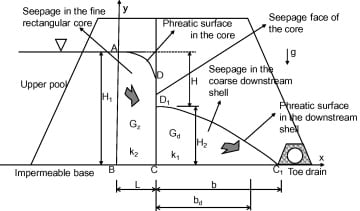Table of Contents
In this article, we will discuss the design of filter.
1. Introduction
In civil engineering problems quite often, it is required to divert the percolating water out of the soil into wells and ditches or towards the conduits located beneath the foundation. This procedure is known as drainage. To execute such an operation a coarse-grained material is usually called a filter.
It is provided between the native soil and the drainage structure. The natural soil is called the base material. If the filter has larger voids than those of the base material particles from the base material are liable to get washed away and fill the ices of the filter material.

As a result, there will be an obstruction of flow. On the other hand if the voids f the filter material, as well as the base material, are almost the same most likely both of the materials may be washed out to drainage structure and carried away. Both of these situations are not desirable. To get rid of such undesirable conditions, the filter material must fulfill certain requirements.
The design of the filter is largely empirical. The design of a proper filter lies in choosing the material and dimension of the filter. The design should be such that it must be fine enough to prevent soil particles from being washed through it and yet coarse enough to allow the free passage of water. The essential requirements for filter material have been determined experimentally by Terzaghi in 1942. They are based primarily on the grain size distribution of the filter and base material. They are summarized below.
Terzaghi’s rule Terzaghi developed the following formula.
D15filter > 4 x D15 of base material ….. 1
D15 filter < 4 x D85 of base material ….. 2
D50 filter < 20 x D50 of base material ….. 3
Eq.1 is the requirement to prevent piping. Eqs 2 and 3 are requirements to ensure that the permeability of the soil is high enough for drainage purposes. The thickness of the filter can be determined from Darcy’s law. To provide free drainage, the coefficient of permeability of the filter should be 25 times or more than the base material.
2. Graded Filter
A filter consisting of layers of impervious materials is known graded filter. Graded filter permits the flow of water but prevents the movement of s perfect working of filter, the particle size of different materials is the design criteria discussed above. In graded filter, each layer is designed considering as a flute preceding layer as a base material. The particle size of the layers increases the direction of flow.
| Read More: Drip Irrigation |
The material of the last layer s coarse enough not to be carried away through the openings of perforated pipes. For the circular opening of the drainage pipe, D85 of the design of filter material is greater than 1.2 times the diameter of the hole. For slotted openings of era pipe, D85 of the filter material should be greater than 1.4 times the width hole. In general, the D85 of the design of filter material should be equal to or greater than both types of openings.
| Read More: Surge Tanks |

